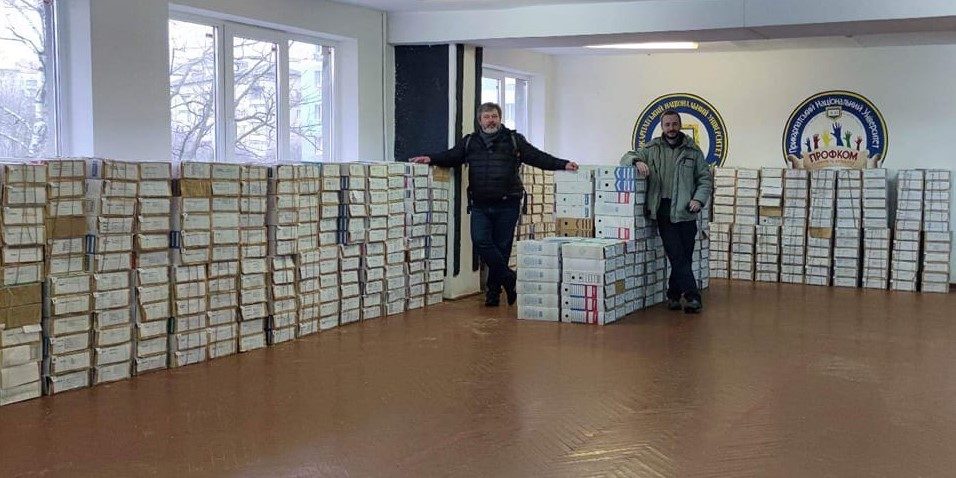The second operation to save the herbarium in 100 years was successful (the first, by the way, took place at Kharkiv University during the Second World War). This would not have happened without our colleagues from UNCG, professors of Kherson State University Ivan Moisienko and Oleksandr Khodosovtsev.
“When we were still in occupied Kherson, in March, we already thought that the herbarium should somehow be preserved. It was impossible to take it out then, as it would have to be moved across the front line. Then we thought about the most valuable specimens – reference or typical specimens. Any herbarium flaunts such specimens. We had about 200 of them. In the first days of the occupation, we hid them in the basement of the university,” says Oleksandr Khodosovtsev.
The occupying authorities did not know about the valuable 24 boxes. As soon as the city was liberated, the first thing scientists did was take typical samples. The people who brought the volunteer aid agreed to take the herbarium in the already empty bus when leaving the city. So, on December 2, the first batch of herbarium was taken to a safe place.
However, scientists did not stop there.
Herbarium specimens are, in fact, an extraordinary value of the university, they have been collected by scientists for the past 50 years and you will not collect them a second time. It was necessary to think about how to take out the entire herbarium (which is almost 32,000 specimens), because after leaving the “russian city of Kherson”, the occupiers began to shell it intensively.
“Daria Shiryaeva started this conversation for the first time. She is currently undergoing an internship in the Czech Republic. Thanks to her, we were able to talk to GBIF, an organization that collects biodiversity data from around the world. The guys talked and urgently allocated minimal funds to order a truck and boxes. By the end of 2022, we planned to take the herbarium to the location of our university – to Vasyl Stefanyk Prykarpattia National University. The rectors very quickly agreed among themselves on the allocation of space,” recalls Oleksandr Khodosovtsev.
From December 19 to 21, Oleksandr completed the herbarium of lichens and lichenophilic fungi. In total, a little more than 750 tape-wrapped boxes turned out. At that time, Ivan was looking for plastic containers, because unlike the herbarium of lichens, which was stored in boxes, the herbarium of vascular plants was placed on the shelves of cabinets in the open. At the beginning of January, the work on packing the herbarium of vascular plants continued.
“The most difficult thing for me was to find plastic boxes,” smiles Ivan Moisienko, “there were more than 200 boxes in total. I bought plastic boxes in parts, in one store there were 12, in another 11, 23, 29, a maximum of 50. I visited many stores in Kyiv. He went to the post office, put them in a cardboard box and sent them to Kherson. 23 parcels with boxes came out.”
The work of the rescuers of the herbarium was carried out under continuous fire. But there were so many of them that no one paid attention to the explosions. They worked without light. And without ladders, which somewhat complicated the process:
“We had 2 ladders in the pulpit, because there are cabinets up to the ceiling. And the Russians stole these ladders. So all the time I had to climb on the table, take out the herbarium, climb down, put it in boxes, and then again… It was physically difficult, there was cramping, I came home and couldn’t move,” admits Ivan Moisienko.
Two scientists worked, sometimes they were helped by colleagues from the department (associate professor Nataliya Zagorodnyuk, and when loading into the car – lecturer Maryna Zakharova). No one was called for help for safety reasons: what if he flies in?
On January 5, the fully loaded truck went to a safe place in Ivano-Frankivsk. Assistant professor of Kharkiv National University, mycologist Oleh Prylutskyi, a lecturer at Vasyl Stefanyk Precarpathian National University, lichenologist Nadiya Kapets, as well as the head of university security Oleksandr Voloshyn and the most active student of the Faculty of Biology, Geography and Ecology of Kherson State University Oleksiy Zakharov. At 10 o’clock in the morning, the last boxes were brought to the temporary location of the herbarium.
The evacuation was successful. A total of 32,000 herbarium specimens in more than 1,000 boxes were exported. Of these, 16,000 are lichens and fungi, 15,000 are vascular plants, and about 1,000 are mosses. No samples were affected. This is how the second operation to save the herbarium in Ukraine ended.
And 2 days after the herbarium was taken away, a second shelling occurred near the university. One of the arrivals was right next to the place where herbarium specimens were stored for transshipment.
Photo by Oleksandr Khodosovtsev
Author Tetyana Shamina







